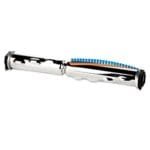If your vacuum cleaner stops working, first check the power source and the filter. Ensure that it’s not clogged.
A malfunctioning vacuum cleaner can be frustrating. Regular maintenance can often prevent issues. Start by inspecting the power cord and plug for any damages. Check the filter and bag; a clogged filter can hinder performance. Ensure that the brush roll is free of hair and debris.
Sometimes, the problem lies in the belt; a worn-out belt can stop the vacuum from working effectively. Regularly clean and inspect all parts to avoid future problems. Understanding these basic troubleshooting steps can save time and money. Keeping your vacuum cleaner in good condition ensures efficient cleaning and prolongs its lifespan.
Common Issues
Vacuum cleaners are essential for keeping our homes clean. They can sometimes stop working. Understanding common issues can help solve the problem quickly.
One common issue is power problems. If your vacuum cleaner won’t turn on, check the power source first. Ensure it’s plugged in properly. You might also check the circuit breaker. Sometimes, the vacuum cleaner’s power switch may be faulty. Inspect the power cord for any visible damage. A damaged cord can prevent electricity flow.
- Check the power source.
- Inspect the circuit breaker.
- Examine the power switch.
- Look for cord damage.
Suction loss is another common problem. When your vacuum cleaner loses suction, it can’t clean effectively. First, check the vacuum bag or dirt canister. If they are full, empty them. A clogged filter can also cause suction loss. Clean or replace the filter as needed. Inspect the hose and attachments for blockages. Remove any debris you find.
- Empty the vacuum bag or canister.
- Clean or replace the filter.
- Check the hose and attachments for clogs.
| Common Issue | Possible Solution |
|---|---|
| Power Problems | Check the power source, circuit breaker, power switch, and cord. |
| Suction Loss | Empty bag/canister, clean/replace filter, remove hose blockages. |
Power Problems
Your vacuum cleaner stops working. This can be very frustrating. The issue might be with the power. Let’s explore common power problems. We’ll help you fix them easily.
Check Power Source
Ensure your vacuum is plugged in properly. Sometimes the plug gets loose. Check the outlet. Try another device in the same outlet. If it doesn’t work, the outlet might be the problem.
- Plug: Securely plugged in?
- Outlet: Test with another device.
Inspect for any tripped circuit breakers. Locate your home’s circuit breaker panel. Flip the switch back to its original position.
Inspect Power Cord
Examine the power cord for any damage. Sometimes cords get frayed or broken. A damaged cord can stop the vacuum from working.
- Check for cuts or tears: Any visible damage?
- Feel for weak spots: Any soft or flexible areas?
If you find damage, stop using the vacuum. Replace the cord or seek professional repair. Safety first!
| Action | Details |
|---|---|
| Check Plug | Ensure it’s securely plugged in. |
| Test Outlet | Try another device in the same outlet. |
| Inspect Cord | Look for any cuts or tears. |
| Feel Cord | Check for weak or soft spots. |
Always handle electrical issues with care. If unsure, call a professional. Your safety is important.
Suction Loss
Vacuum cleaners are essential for keeping our homes clean. But sometimes they stop working. One common issue is suction loss. Suction loss means your vacuum isn’t picking up dirt well. This can be frustrating. Here are some tips to fix it.
Clogged Filters
Clogged filters are a common cause of suction loss. Filters trap dirt and dust. Over time, they get dirty. When filters are clogged, air can’t flow through. This reduces suction power.
Check your vacuum’s filters regularly. Most vacuums have two types of filters:
- Pre-motor filters
- HEPA filters
Pre-motor filters are usually washable. Rinse them under water and let them dry. HEPA filters may need replacing. Check your vacuum’s manual for instructions. Clean or replace filters every few months.
Blocked Hose
A blocked hose can also cause suction loss. Hoses can get clogged with debris. This prevents air from flowing through. To check for a blockage, disconnect the hose.
Use a long stick to push through the hose. If it doesn’t go through, you have a blockage. Remove the debris carefully. Reattach the hose and test the vacuum.
Here is a simple checklist to troubleshoot:
- Check filters for clogs
- Clean or replace filters
- Inspect hose for blockages
- Remove any debris from the hose
Following these tips can help restore your vacuum’s suction power. Regular maintenance keeps your vacuum working well.
Strange Noises
Vacuum cleaners are essential for keeping your home clean. But sometimes, they make strange noises. This can be worrying. Understanding these sounds can help fix the problem.
Motor Issues
The motor is the heart of your vacuum cleaner. If it makes odd noises, there might be a problem. Check if the motor is overheating. An overheated motor can cause strange sounds. Let it cool down before you inspect further. Another common issue is dirt inside the motor. Clean any dirt or debris. This can improve the motor’s performance.
Loose Parts
Loose parts can also cause strange noises. Check the screws and bolts. They might have come loose. Tighten any loose parts you find. Look at the brush roll. It can make noise if not attached properly. Ensure it is secure. Examine the vacuum hose. A loose hose can create a whistling sound. Make sure it is firmly connected.
| Problem | Possible Cause | Solution |
|---|---|---|
| Overheating Motor | Blocked airways | Clean filters and airways |
| Noise from Brush Roll | Loose attachment | Secure the brush roll |
| Whistling Sound | Loose hose | Reconnect the hose |
Follow these steps to address strange noises. Your vacuum cleaner should work smoothly again. Regular maintenance can prevent these issues. Keep your vacuum clean and check for loose parts often.
Overheating
Is your vacuum cleaner stopping suddenly? It might be overheating. Overheating can cause your vacuum to shut down. This protects the motor. Let’s look at some common causes and solutions.
Blocked Airflow
Blocked airflow makes the motor work harder. This can lead to overheating.
Check for blockages in the hose or brush head. Follow these steps:
- Turn off and unplug the vacuum.
- Remove the hose and brush head.
- Look for any clogs or debris.
- Use a long object to clear any blockages.
- Reattach the hose and brush head.
Regularly checking for blockages keeps your vacuum running smoothly.
Clean Filters
Dirty filters restrict airflow and cause overheating. Clean or replace filters regularly.
Follow these steps to clean the filters:
- Turn off and unplug the vacuum.
- Remove the filters from the vacuum.
- Tap the filters gently to remove dust.
- Rinse washable filters under water.
- Let filters dry completely before reattaching.
Check your vacuum manual for specific filter cleaning instructions.

Credit: www.angi.com
Brush Roll Issues
A common problem with vacuum cleaners is brush roll issues. The brush roll is crucial for picking up dirt and debris. When it stops working, your vacuum cleaner loses efficiency. This section will help you tackle two main problems: tangled debris and a worn brush.
Tangled Debris
If your brush roll stops spinning, it may be due to tangled debris. Hair, string, and other materials can wrap around the brush. This prevents it from rotating properly.
To fix this, turn off and unplug your vacuum cleaner. Carefully remove the brush roll. Use scissors to cut away any tangled debris. Be gentle to avoid damaging the brush.
- Turn off and unplug the vacuum.
- Remove the brush roll.
- Use scissors to cut tangled debris.
- Reinstall the brush roll.
Worn Brush
A worn brush can also cause issues. Over time, the bristles on the brush roll wear down. This reduces the vacuum’s cleaning ability.
To check if your brush is worn, compare it to a new one. If the bristles are short or uneven, replace the brush roll.
| Step | Action |
|---|---|
| 1 | Turn off and unplug the vacuum. |
| 2 | Remove the brush roll. |
| 3 | Compare the brush to a new one. |
| 4 | If worn, replace the brush roll. |
| 5 | Reinstall the new brush roll. |
Taking care of your brush roll keeps your vacuum cleaner running smoothly. Regular maintenance ensures a longer lifespan for your device. Always check for tangled debris and worn brushes.
Bag Or Bin Problems
One common issue with vacuum cleaners is related to the bag or bin. If your vacuum cleaner stops working, the first thing to check is the bag or bin. Problems with these components can cause performance issues. Let’s explore some troubleshooting tips.
Full Bag
A full bag can make your vacuum cleaner stop working. If the bag is full, the vacuum cannot suck up more dirt. Follow these steps to check and change the bag:
- Turn off and unplug the vacuum cleaner.
- Open the bag compartment.
- Remove the full bag carefully.
- Dispose of the old bag properly.
- Insert a new bag into the compartment.
- Close the bag compartment securely.
Always check the bag’s capacity indicator. This helps avoid overfilling, which can block airflow.
Improper Installation
Sometimes the bag or bin might not be installed correctly. An improper installation can cause the vacuum to malfunction. To ensure proper installation, follow these steps:
- Turn off and unplug the vacuum cleaner.
- Open the bag or bin compartment.
- Check if the bag or bin is correctly aligned.
- Reinstall the bag or bin if necessary.
- Make sure it clicks into place.
Ensuring the bag or bin is properly installed can prevent many issues. Always double-check the installation if your vacuum stops working.

Credit: slate.com
Maintenance Tips
Vacuum cleaners are essential for keeping your home clean. Regular maintenance keeps them running smoothly. Follow these tips to ensure your vacuum cleaner works efficiently.
Regular Cleaning
Regular cleaning of your vacuum cleaner is crucial. Here are steps to follow:
- Empty the dustbin or replace the bag frequently.
- Check and clean the filter regularly.
- Remove hair and debris from the brush roll.
- Inspect the hoses for blockages.
A clean vacuum works better and lasts longer.
Proper Storage
Proper storage is important for your vacuum cleaner. Follow these tips to store it correctly:
- Keep the vacuum in a dry place.
- Store it in an upright position.
- Wrap the cord neatly to avoid damage.
- Ensure all attachments are stored safely.
Proper storage extends the life of your vacuum.

Credit: www.amazon.com
Frequently Asked Questions
Why Would A Vacuum Cleaner Suddenly Stop Working?
A vacuum cleaner may stop working due to a clogged filter, full dustbin, power issues, or a malfunctioning motor.
What Is The Most Common Problem With Vacuum Cleaners?
The most common problem with vacuum cleaners is clogged filters or hoses. This reduces suction power and efficiency. Regular maintenance, such as cleaning or replacing filters, can help prevent this issue.
How To Fix A Vacuum Not Working?
Check for clogs in the hose or filters. Empty the dust bin. Inspect the power cord and plug. Replace worn belts. Clean or replace filters regularly.
How Do You Know If Your Vacuum Motor Is Burnt Out?
A burnt-out vacuum motor may emit a burning smell, make unusual noises, or stop working entirely. Check for these signs.
Conclusion
Fixing a broken vacuum cleaner can be simple with the right steps. Follow these troubleshooting tips carefully. Regular maintenance will keep your vacuum running smoothly. If problems persist, consider professional help. Keep your home clean and your vacuum in top shape with these easy solutions.
Happy cleaning!





